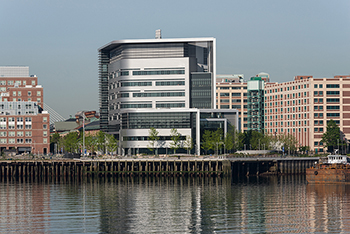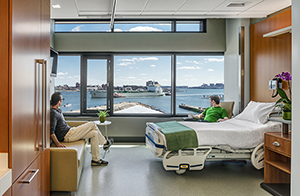Perkins+Will Leads Sustainable Health Care Design Movement
 NEW YORK — Perkins+Will is making strides to create green, healthy health care facilities to promote the healing of patients and pave a new path for sustainable hospital design. The global architecture and design firm has completed 21 LEED health care projects, nine of which are hospitals.
NEW YORK — Perkins+Will is making strides to create green, healthy health care facilities to promote the healing of patients and pave a new path for sustainable hospital design. The global architecture and design firm has completed 21 LEED health care projects, nine of which are hospitals.
The LEED hospitals designed by Perkins+Will account for approximately 10 percent of all U.S. Green Building Council LEED-certified hospitals. According to Breeze Glazer, LEED AP, associate and research knowledge manager with Perkins+Will, said hospitals must advance the health and healings of patients and also minimize ecological harm.
“If we continue to build health care buildings that pollute and use building materials that have toxic chemicals in them, it will be quite hard to treat people and make them healthier if the building itself isn’t a tool for healing, but rather an obstacle,” Glazer said.
In order to have healthy people, Glazer said, health care buildings need to strive to do less harm. In order for a health care building to be a tool in the healing process, the building must be viewed holistically. Health care building projects should use fewer pollutants and more healthy materials, Glazer said, and include connections to nature and daylight in the facility’s design.
Perkins+Will also places emphasis on collaboration with clients in order to provide the most healing environment possible.
 “People heal people. Our clients collaborate with us to design projects that promote healing by creating a desirable environment for the caregivers and medical professionals as well as the patients themselves,” said Robin Guenther, FAIA, LEED AP, principal and sustainable health care design leaders with Perkins+Will, in a statement. “We approach every project with a sustainable goal in mind that is site specific and contextual — we use sustainability to connect people to place. It is our way of supporting global, community and individual health — creating sustainable, healing places of treatment and research.”
“People heal people. Our clients collaborate with us to design projects that promote healing by creating a desirable environment for the caregivers and medical professionals as well as the patients themselves,” said Robin Guenther, FAIA, LEED AP, principal and sustainable health care design leaders with Perkins+Will, in a statement. “We approach every project with a sustainable goal in mind that is site specific and contextual — we use sustainability to connect people to place. It is our way of supporting global, community and individual health — creating sustainable, healing places of treatment and research.”
The firm has made several advancements in the field of sustainable health care design. In Chicago, Perkins+Will designed the largesse LEED-certified hospital to date at the Rush University Medical Center. Spaulding Rehabilitation Hospital in Boston became the first hospital in the Northeast to account for climate change and sea level rise. The design of Moses Cone Memorial Hospital in Greensboro, N.C., included the first application of chilled beams in every room of an acute care hospital. The firm also designed the first carbon neutral hospital in British Columbia, as well as the first LEED-certified hospital in Latin America.
These designs were significant in the green health care movement because health care institutions tend to be hesitant in taking on new building risks.
“Very few hospitals want to be the first to do anything,” Glazer said. “Everyone wants to be second.”
When a health care facility achieves sustainable success with a new green strategy, this then opens the door to other health care facilities to seek out those same green building methods. The end result will be more hospitals seeking out more healthy, sustainable advancements for the benefit of health care patients, staff and the public, Glazer said.
